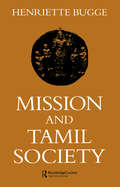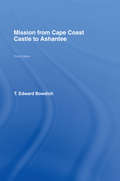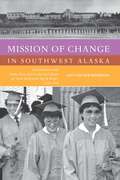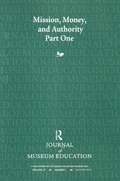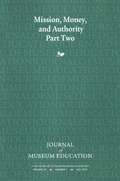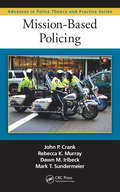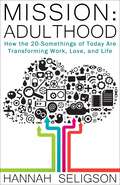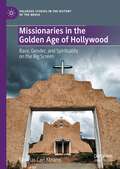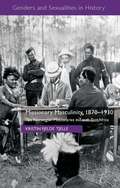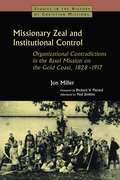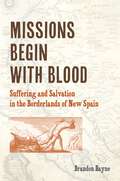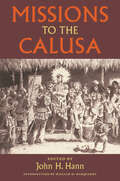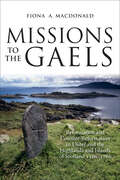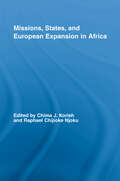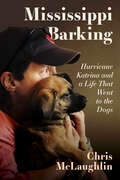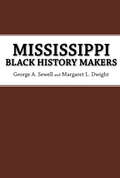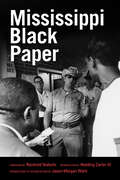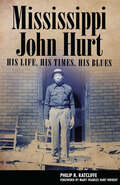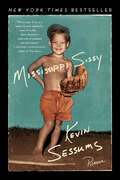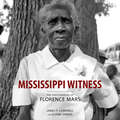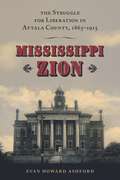- Table View
- List View
Mission and Tamil Society: Social and Religious Change in South India (1840-1900)
by Henriette BuggeLooks to provide an analysis of religion as a dynamic factor in Indian society. Not only is the ritual, economic and power status of the missionaries examined but also such effects on their converts as social status and mobility.
Mission from Cape Coast Castle to Ashantee (1819): With A Descriptive Account Of That Kingdom (classic Reprint)
by T.E. BowdichFirst Published in 1966. Routledge is an imprint of Taylor & Francis, an informa company.
Mission of Change in Southwest Alaska: Conversations with Father René Astruc and Paul Dixon on Their Work with Yup’ik People
by Ann Fienup-RiordanMission of Change is an oral history describing various types of change—political, social, cultural, and religious—as seen through the eyes of Father Astruc and Paul Dixon, non-Natives who dedicated their lives to working with the Yup’ik people. Their stories are framed by the an analytic history of regional changes, together with current anthropological theory on the nature of cultural change and the formation of cultural identity. The book presents a subtle and emotionally moving account of the region and the roles of two men, both of whom view issues from a Catholic perspective yet are closely attuned to and involved with changes in the Yup’ik community.
Mission, Money, and Authority, Part One: Journal of Museum Education 35:2 Thematic Issue
by Tina R. NolanSponsored by the Museum Education Roundtable, this is volume 35, Number 2 of the Journal of Museum Education (JME) Part One of Mission, Money, and Authority, published in the summer of 2010. This edition includes articles on museums and other non-profits in the current recession; project fundraising; managing museum priorities in a difficulty economy; obtaining support and reducing obstacles; the value of online learning and making programs self-sustaining.
Mission, Money, and Authority, Part Two: Journal of Museum Education 35:3 Thematic Issue (Journal of Museum Education)
by Tina R. NolanSponsored by the Museum Education Roundtable, this is volume 35, Number 3 of the Journal of Museum Education (JME) Part Two of Mission, Money, and Authority, published in the fall of 2010. This edition includes articles on insistent questions in our learning age, the museum’s economic footprint, putting art into work revenue, when education meets admissions, generating museum education programs for knowledge and three case studies on money and the mission.
Mission-Based Policing (Advances in Police Theory and Practice)
by John P. Crank Dawn M. Irlbeck Rebecca K. Murray Mark SundermeierThe research revolution in police work has uncovered a multitude of data, but this contemporary knowledge has done very little to change the way things are done in most police departments across the U.S., where the prevalent form of policing is based on the traditional model of district assignments and random preventive patrol. Drawn from the work of scholars on the cutting edge of police research, this volume argues for a radical shift in the way policing is approached. It provides concrete recommendations for the fundamental reorganization of the policing institution and presents a comprehensive planning regimen for urban problems that encompasses security, urban reinvestment, and public planning.
Mission: How the 20-Somethings of Today Are Transforming Work, Love, and Life
by Hannah SeligsonGen Y has been picked apart by analysts, statistics, and trend reports, which often portray 20-somethings in negative, one-dimensional terms like "entitled" and "whiners". In this thought-provoking new book that aims to dispel these stereotypes, journalist Hannah Seligson chronicles the lives of seven individuals who embody this generation, exploring their challenges and ambitions in vivid detail and sketching a picture, through their eyes, of what life is actually like for young adults. Through these first-hand stories, readers will discover the transformational effect this enterprising, open-minded, innovative, and diverse generation is having on society."Zeitgeist reporter Hannah Seligson details this new path to adulthood in a book that promises to be illuminating, surprising, and provocative— both for Gen Y readers themselves and for people who want to understand this charming yet sometimes infuriating generation. I need this book. What is "nexting" and "jacked"? —Gretchen Rubin, New York Times Bestselling Author of THE HAPPINESS PROJECT and HAPPIER AT HOME
Missionaries in the Golden Age of Hollywood: Race, Gender, and Spirituality on the Big Screen (Palgrave Studies in the History of the Media)
by Douglas Carl AbramsThis book examines major British and American missionary films during the Golden Age of Hollywood to explore the significance of race, gender, and spirituality in relation to the lives of the missionaries portrayed in film during the middle third of the twentieth century. Film both influences and reflects culture, and racial, gender, and religious identities are some of the most debated issues globally today. In the movies explored in this book, missionary interactions with various people groups reflect the historical changes which took place during this time.
Missionaries, Rebellion and Proto-Nationalism: James Long of Bengal
by Geoffrey A. OddieThe Rev. James Long was one of the most remarkable Protestant missionaries working in India in the nineteenth century. Sent to Calcutta at the age of 22 in 1840, he devoted his life to representing what he passionately believed were the best interests of the forgotten poor and oppressed among the Bengali population. Long was a central figure in the indigo planting controversy of 1861 and suffered imprisonment as a result. His memory is revered even today in modern India, where his contribution to the development of Bengali vernacular education, literature, history, and sociology is highly regarded. Dr Oddie has produced the first full-length biography of Rev Long, examining his work and activities in the context of his own background, philosophy and motivation as well as the political and cultural climate of the day. This book will add significantly to our knowledge of social movements in nineteenth century India and the colonial responses to them.
Missionary Discourses of Difference
by Esme CleallMissionary Discourse examines missionary writings from India and southern Africa to explore colonial discourses about race, religion, gender and culture. The book is organised around three themes: family, sickness and violence, which were key areas of missionary concern, and important axes around which colonial difference was forged.
Missionary Encounters: Sources And Issues
by Robert A. Bickers Rosemary SetonDescribes the exceptional wealth of missionary archives and the major contributions they can make not only to the study of the processes of Christian evangelism and Western imperialism but also their value in documenting and analysing the nature of Western encounters with indigenous societies.
Missionary Masculinity, 1870–1930
by Kristin Fjelde TjelleWhat kind of men were missionaries? What kind of masculinity did they represent, in ideology as well as in practice? Presupposing masculinity to be a cluster of cultural ideas and social practices that change over time and space, and not a stable entity with a natural, inherent meaning, Kristin Fjelde Tjelle seeks to answer such questions.
Missionary Zeal and Institutional Control: Organizational Contradictions in the Basel Mission on the Gold Coast 1828-1917 (Studies In The History Of Christian Missions)
by Jon MillerThis book is about the Basel Mission in the Gold Coast (now Ghana) before the First World War. Miller reconstructs the backgrounds and motivations of the mission's participants and describes the organizational structure that shaped their activities at home and abroad. He then traces some serious and recurrent internal problems to the commitment to difficult Pietist beliefs about authority and obedience. The organization survived those troubles and its impact on Ghana continued to grow, because the same biblical worldview that demanded extreme discipline also prepared the members of the mission community to sustain their efforts.
Missions Begin with Blood: Suffering and Salvation in the Borderlands of New Spain (Catholic Practice in North America)
by Brandon BayneWinner, 2022 Frank S. and Elizabeth D. Brewer PrizeWhile the idea that successful missions needed Indigenous revolts and missionary deaths seems counterintuitive, this book illustrates how it became a central logic of frontier colonization in Spanish North America. Missions Begin with Blood argues that martyrdom acted as a ceremony of possession that helped Jesuits understand violence, disease, and death as ways that God inevitably worked to advance Christendom. Whether petitioning superiors for support, preparing to extirpate Native “idolatries,” or protecting their conversions from critics, Jesuits found power in their persecution and victory in their victimization. This book correlates these tales of sacrifice to deep genealogies of redemptive death in Catholic discourse and explains how martyrological idioms worked to rationalize early modern colonialism. Specifically, missionaries invoked an agricultural metaphor that reconfigured suffering into seed that, when watered by sweat and blood, would one day bring a rich harvest of Indigenous Christianity.
Missions to the Calusa (Florida Museum of Natural History: Ripley P. Bullen Series)
by John H. HannA compilation of historical documents written by Europeans during the colonization of southwest FloridaWhen Europeans arrived in southwest Florida in the early sixteenth century, they encountered a complex and powerful society. The Calusa have posed an enigma to many anthropologists and historians. This work provides missing information on the ethnography of the Calusa, a society that inhabited the area of Florida now known as Charlotte, Lee, and Collier counties. This compilation of historical documents includes many reports never before translated into English, including letters from Pedro Menéndez, reports from King Charles II and governors, bishops, and soldiers, and eyewitness testimony from priests and laypersons about mission efforts from the sixteenth through the eighteenth centuries.John Hann introduces Spanish contact with the Calusa from the early seventeenth century, focusing particularly on the ill-fated Franciscan attempt in 1697 to convert the Calusa to Christianity. His voluminous documentation for this effort is particularly valuable for its description of the role played by the Crown in instigating the mission despite little enthusiasm from religious authorities.A volume in the Florida Museum of Natural History: Ripley P. Bullen Series
Missions to the Gaels: Reformation and Counter-Reformation in Ulster and the Highlands and Islands of Scotland 1560–1760
by Fiona A. MacDonaldThis book is an extended study, in the Post-Reformation period, of the impact of the Gaels in the west of Scotland and the north of Ireland on each other’s religious heritage. Beginning half a century before the plantation of Ulster, Missions to the Gaels illuminates the origins of the sectarian divisions in Northern Ireland. The research deals with both Protestants and Catholics, rather than treating only one denomination in isolation. The author explores the intriguing situation whereby Scottish Gaelic-speaking ministers laid the foundations of the embryonic Protestant Church in Ireland, while at the same time Irish-speaking priests were almost exclusively responsible for the reintroduction of Catholicism to the Highlands and Islands of Scotland. The range of this book extends beyond narrow ecclesiastical issues: it reveals the broader political and cultural forces that determined the Gaels’ choice of religious alignment and traces the effects of these over two centuries of turbulent change in Gaelic society.
Missions, States, and European Expansion in Africa (African Studies)
by Raphael Chijioke Njoku Chima J. KoriehMissions, States, and European Expansion in Africa aims to explore the ways Christianity and colonialism acted as hegemonic or counter hegemonic forces in the making of African societies. As Western interventionist forces, Christianity and colonialism were crucial in establishing and maintaining political, cultural, and economic domination. Indeed, both elements of Africa’s encounter with the West played pivotal roles in shaping African societies during the nineteenth and twentieth centuries. This volume uses a wide range of perspectives to address the intersection between missions, evangelism, and colonial expansion across Africa. The contributors address several issues, including missionary collaboration with the colonizing effort of European powers; disagreements between missionaries and colonizing agents; the ways in which missionaries and colonial officials used language, imagery, and European epistemology to legitimize relations of inequality with Africans; and the ways in which both groups collaborated to transform African societies. Thus, Missions, States, and European Expansion in Africa transcends the narrow boundaries that often separate the role of these two elements of European encounter to argue that missionary endeavours and official colonial actions could all be conceptualized as hegemonic institutions, in which both pursued the same civilizing mission, even if they adopted different strategies in their encounter with African societies.
Mississippi Barking: Hurricane Katrina and a Life That Went to the Dogs
by Chris McLaughlinWinner of a 2023 Best Book Award in the category of Animals/Pets: Narrative Nonfiction from American Book FestOn August 29, 2005, the worst natural disaster in the history of the United States devastated the city of New Orleans and the Gulf Coast of Louisiana and Mississippi. Like many others in America and around the world, Chris McLaughlin watched the tragedy of Katrina unfold on a television screen from the comfort of her living room on Cape Cod in Massachusetts. In the devastation afterwards, almost 2,000 people and an estimated 250,000 animals had perished. Miraculously, many pets did manage to survive. But in the months that followed the hurricane, thousands of them were fending for themselves in the ruins of devastated neighborhoods. They roamed the streets in feral packs or struck out alone. Their plight triggered a grassroots rescue effort unlike any this country had ever seen, and while relief organizations such as the Red Cross were tending to the human survivors, and movie stars and celebrities were airlifting food and endorsing seven-figure checks, a much smaller and meagerly funded effort was underway to save the four-legged victims. With no prior experience in disaster response and no real grasp of the hell that awaited them, scores of animal lovers, including McLaughlin, made their way to the Gulf Coast to help in any way they could. Including photos from four-time Pulitzer Prize–winning photojournalist Carol Guzy, Mississippi Barking spans the course of two years as McLaughlin and others ventured into the wreckage of the Gulf Coast to rescue the animals left behind. McLaughlin tells the moving stories of the people she met along the way, both those who lost everything to the hurricane and those working beside her rescuing and transporting animals away from the neglected, derelict conditions in which they barely survived. Within this story of tragedy and cruelty, suffering and ignorance, Mississippi Barking also bears witness to selfless acts of bravery and compassion, and the beauty and heroics of those who risked everything to save the animals that could not save themselves.
Mississippi Black History Makers
by George A. Sewell Margaret L. DwightThis book of biographical sketches of notable African Americans from Mississippi includes a total of 166 figures, all who have made significant contributions.Black history makers are defined herein as those who have achieved national prominence in their fields, who have made lasting contributions within the state as pioneers in their fields, or who contributed to their own communities or fields as role models. Each of those included in the book either was born in Mississippi, spent a part of their childhood there, or migrated to Mississippi and remained. History makers covered include Hiram R. Revels, the first Black US Senator; Blanche K. Bruce, the first Black US Senator to serve a six-year term; political and civil rights leaders such as Aaron Henry, Medgar Evers, and Fannie Lou Hamer; William Johnson, a free Black man from antebellum Natchez; Margaret Murray Washington, wife of Booker T. Washington; Walter Payton, former running back for the Chicago Bears; and contributors to arts and letters such as Leontyne Price, William Grant Still, Margaret Walker Alexander, James Earl Jones, and “Bo Diddley” McDaniel, a pioneer rock-and-roll musician; as well as other notable Black Mississippians. The book is organized into ten thematic sections: politics, civil rights, business, education, performing and visual arts, journalism and literature, military, science/medicine/social work, sports, and religion. And each section is introduced by an historical overview of this field in the state of Mississippi. This book is a valuable reference work for those wishing to assess the contributions of African Americans to the history of Mississippi. Of particular significance is the fact that it is a collection which brings attention to lesser-known figures as well as those of considerable renown.
Mississippi Black Paper (Civil Rights in Mississippi Series)
by Reinhold Niebuhr, Hodding Carter III and Jason Morgan WardAt the height of the civil rights movement in Mississippi, as hundreds of volunteers prepared for the 1964 Freedom Summer Project, the Council of Federated Organizations (COFO) compiled hundreds of statements from activists and everyday citizens who endured police abuse and vigilante violence. Fifty-seven of those testimonies appear in Mississippi Black Paper. The statements recount how white officials and everyday citizens employed assassinations, beatings, harassment, and petty meanness to block any change in the state's segregated status quo. The testimonies in Mississippi Black Paper come from well-known civil rights heroes such as Fannie Lou Hamer, Aaron Henry, and Rita Schwerner, but the book also brings new voices and stories to the fore. Alongside these iconic names appear grassroots activists and everyday people who endured racial terror and harassment for challenging, sometimes in seemingly imperceptible ways, the state's white supremacy. This new edition includes the original foreword by Reinhold Neibuhr and the original introduction by Mississippi journalist Hodding Carter III, as well as Jason Morgan Ward's new introduction that places the book in its context as a vital source in the history of the civil rights movement.
Mississippi John Hurt: His Life, His Times, His Blues (American Made Music Series)
by Philip R. RatcliffeWinner, Best History, 2012 Association for Recorded Sound Collections Award for Excellence in Historical Recorded Sound ResearchWhen Mississippi John Hurt (1892-1966) was "rediscovered" by blues revivalists in 1963, his musicianship and recordings transformed popular notions of prewar country blues. At seventy-one he moved to Washington, D.C., from Avalon, Mississippi, and became a live-wire connection to a powerful, authentic past. His intricate and lively style made him the most sought after musician among the many talents the revival brought to light.Mississippi John Hurt provides this legendary creator's life story for the first time. Biographer Philip Ratcliffe traces Hurt's roots to the moment his mother Mary Jane McCain and his father Isom Hurt were freed from slavery. Anecdotes from Hurt's childhood and teenage years include the destiny-making moment when his mother purchased his first guitar for $1.50 when he was only nine years old. Stories from his neighbors and friends, from both of his wives, and from his extended family round out the community picture of Avalon. US census records, Hurt's first marriage record in 1916, images of his first autographed LP record, and excerpts from personal letters written in his own hand provide treasures for fans. Ratcliffe details Hurt's musical influences and the origins of his style and repertoire. The author also relates numerous stories from the time of his success, drawing on published sources and many hours of interviews with people who knew Hurt well, including the late Jerry Ricks, Pat Sky, Stefan Grossman and Max Ochs, Dick Spottswood, and the late Mike Stewart. In addition, some of the last photographs taken of the legendary musician are featured for the first time in Mississippi John Hurt.
Mississippi Sissy
by Kevin Sessums“A book I’ve been waiting for most of my life . . . by a writer who is equally at home with Flannery O’Connor and Jacqueline Susann.” —Michael Cunningham, Pulitzer Prize–winning author Mississippi Sissy is the stunning memoir from Kevin Sessums, a celebrity journalist who grew up scaring other children, hiding terrible secrets, pretending to be Arlene Frances and running wild in the South.As he grew up in Forest, Mississippi, befriended by the family maid, Mattie May, he became a young man who turned the word “sissy” on its head, just as his mother taught him. In Jackson, he is befriended by Eudora Welty and journalist Frank Hains, but when Hains is brutally murdered in his antebellum mansion, Kevin’s long road north towards celebrity begins. In his memoir, Kevin Sessums brings to life the pungent American south of the 1960s and the world of the strange little boy who grew there.“Mississippi Sissy is an unforgettable memoir. I think it will strike a strong chord with many, many readers. It’s a far different book than Midnight in the Garden of Good and Evil, but it cast the same kind of spell over me while I was reading it.” —Mark Childress, author of Georgia Bottoms“What a writer! What honesty! Kevin Sessums seamlessly weaves his heart-breaking, funny, outrageous, can’t-put-it-down story. Read it! Read it! Read it! Then read it again.” —Ellen DeGeneres“Kevin Sessums is a brilliant writer. He is also a courageous one. Mississippi Sissy is beautifully told—hilarious yet harrowing, tragic yet inspiring. This book will deeply touch anyone who has ever felt different, which means every single one of us.” —E. Lynn Harris, New York Times–bestselling author
Mississippi Solo: A River Quest
by Eddy Harris Eddy L. HarrisSince the publication of his first book, Mississippi Solo, Eddy L. Harris has been praised for his travel writing. In this exciting reissue of his classic travelogue, readers will come to treasure the rich insightful prose that is as textured as the Mississippi River itself. They will be taken by the hand by an adventurer whose lifelong dream is to canoe the length of this mighty river, from Minnesota to New Orleans. The trip's dangers were legion for a Black man traveling alone, paddling from "where there ain't no black folks to where they still don't like us much." Barge waives loom large, wild dogs roam the wooded shores, and, in the Arkansas dusk, two shotgun-toting bigots nearly bring the author's dream to a bloody . Sustaining him through the hard weeks of paddling were the hundreds of people who reached out to share a small piece of his challenge. Mississippi Solo is a big, rollicking, brilliant book, a wonderful piece of American adventure, and an unforgettable story of a man testing his own limits.
Mississippi Witness: The Photographs of Florence Mars
by James T. Campbell Elaine OwensIn June 1964, Neshoba County, Mississippi, provided the setting for one of the most notorious crimes of the civil rights era: the Klan-orchestrated murder of three young voting-rights workers, James Chaney, Michael Schwerner, and Andrew Goodman. Captured on the road between the towns of Philadelphia and Meridian, the three were driven to a remote country crossroads, shot, and buried in an earthen dam, from which their bodies were recovered after a forty-four-day search.The crime transfixed the nation. As federal investigators and an aroused national press corps descended on Neshoba County, white Mississippians closed ranks, dismissing the men’s disappearance as a “hoax” perpetrated by civil rights activists to pave the way for a federal “invasion” of the state. In this climate of furious conformity, only a handful of white Mississippians spoke out. Few did so more openly or courageously than Florence Mars. A fourth-generation Neshoban, Mars braved social ostracism and threats of violence to denounce the murders and decry the climate of fear and intimidation that had overtaken her community. She later recounted her experiences in Witness in Philadelphia, one of the classic memoirs of the civil rights era. Though few remember today, Mars was also a photographer. Shocked by the ferocity of white Mississippians’ reaction to the Supreme Court’s 1954 ruling against racial segregation, she bought a camera, built a homemade darkroom, and began to take pictures, determined to document a racial order she knew was dying. Mississippi Witness features over one hundred of these photographs, most taken in the decade between 1954 and 1964, almost all published here for the first time. While a few depict public events—Mars photographed the 1955 trial of the murderers of Emmett Till—most feature private moments, illuminating the separate and unequal worlds of black and white Mississippians in the final days of Jim Crow.Powerful and evocative, the photographs in Mississippi Witness testify to the abiding dignity of human life even in conditions of cruelty and deprivation, as well as to the singular vision of one of Mississippi’s—and the nation’s—most extraordinary photographers.
Mississippi Zion: The Struggle for Liberation in Attala County, 1865–1915
by Evan Howard AshfordRECIPIENT OF THE 2023 BOOK OF THE YEAR AWARD FROM THE MISSISSIPPI HISTORICAL SOCIETYRECIPIENT OF THE ANNA JULIA COOPER AND C. L. R. JAMES AWARD FOR OUTSTANDING SCHOLARLY PUBLICATION IN AFRICANA STUDIES FROM THE NATIONAL COUNCIL FOR BLACK STUDIES2023 ASALH BOOK PRIZE FINALISTFrom lesser-known state figures to the ancestors of Oprah Winfrey, Morgan Freeman, and James Meredith, Mississippi Zion: The Struggle for Liberation in Attala County, 1865–1915 brings the voices and experiences of everyday people to the forefront and reveals a history dictated by people rather than eras. Author Evan Howard Ashford, a native of the county, examines how African Americans in Attala County, after the Civil War, shaped economic and social politics as a nonmajority racial group. At the same time, Ashford provides a broader view of Black life occurring throughout the state during the same period. By examining southern African American life mainly through Reconstruction and the civil rights movement, historians have long mischaracterized African Americans in Mississippi by linking their empowerment and progression solely to periods of federal assistance. This book shatters that model and reframes the postslavery era as a Liberation Era to examine how African Americans pursued land, labor, education, politics, community building, and progressive race relations to position themselves as societal equals. Ashford salvages Attala County from this historical misconception to give Mississippi a new history. He examines African Americans as autonomous citizens whose liberation agenda paralleled and intersected the vicious redemption agenda, and he shows the struggle between Black and white citizens for societal control. Mississippi Zion provides a fresh examination into the impact of Black politics on creating the anti-Black apparatuses that grounded the state’s infamous Jim Crow society. The use of photographs provides an accurate aesthetic of rural African Americans and their connection to the historical moment. This in-depth perspective captures the spectrum of African American experiences that contradict and refine how historians write, analyze, and interpret southern African American life in the post-slavery era.
